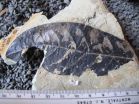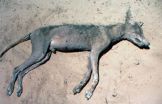(Press-News.org) The landscape of Central Africa 65 million years ago was a low-elevation tropical belt, but the jury is still out on whether the region's mammals browsed and hunted beneath the canopy of a lush rainforest.
The scientific evidence for a tropical rainforest at that time is weak and far from convincing, says paleobotanist Bonnie F. Jacobs at Southern Methodist University in Dallas.
Fossil pollen from Central and West Africa provide no definitive evidence for communities of rainforest trees at the beginning of the Cenozoic, says Jacobs, an expert in the paleobotany of Africa soon after dinosaurs had gone extinct. It was the start of the age of mammals, and Africa was largely an island continent.
Many Cenozoic mysteries remain to be solved
The rainforest mystery is characteristic of the scientific uncertainty and unknowns surrounding Africa's ancient flora during the period called the Cenozoic. There are large gaps in the fossil record, says Jacobs, a co-author of "A Review of the Cenozoic Vegetation History of Africa." She is an associate professor in SMU's Roy M. Huffington Department of Earth Sciences.
The review, a chapter in "Cenozoic Mammals of Africa" (University of California Press, 2010), is the first of its kind since 1978 to review and interpret the Cenozoic paleobotanical record of Africa with paleogeographic maps showing paleobotanical site distributions through time. Jacobs co-authored the paper with Aaron D. Pan, a paleobotanist at the Fort Worth Museum of Science and History, and Christopher R. Scotese, in the Earth Sciences Department at the University of Texas at Arlington.
The 1008-page "Cenozoic Mammals of Africa" is the first comprehensive scientific reference of its kind since 1978, comprising 48 chapters by 64 experts. The volume summarizes and interprets the published fossil research to date of Africa's mammals, tectonics, geography, climate and flora of the past 65 million years.
Details sparse, but big picture emerges for past 65 million years
Paleobotanical data for Africa are generally meager and uneven for the Cenozoic, according to Jacobs and her co-authors.
In an original series of maps, they chart each Cenozoic Africa paleobotanical locale described in the published research to date. There are a mere 82 sites in all. Most of the sites date to 50 million years ago. Fewer date to 20 million, 30 million, 10 million and — perhaps most important — 2 million years ago, when the human family was evolving.
"Africa is disappointingly undersampled," say Jacobs and her colleagues. "This vast continent, roughly three times the area of the United States, has so far been documented by only a handful of Paleogene plant and vertebrate localities, and it has a Neogene record heavily biased toward the depositional basins of the East African Rift."
Shift from descriptive to analytic approach driven by holistic view
For a continent so important for its role in the evolution of mammals, the scarcity of plant fossil data stands in sharp contrast.
"As impressive as is the contemporary mammalian diversity of Africa, it is dwarfed by that of the Cenozoic," write the volume's editors, paleozoologist Lars Werdelin, the Swedish Museum of Natural History, and paleontologist William Joseph Sanders, the University of Michigan. Africa today represents 20 percent of the world's land mass, is the only continent to occupy both the north and south temperate zones, and is home now to more than 1,100 mammalian species, they write in the introduction.
Africa's paleobotanical record is key to a holistic understanding of ancient mammals, says H.B.S. Cooke in the preface. A mammal expert, Cooke was editor of the earlier 1978 scientific reference, "Evolution of African Mammals" (Harvard University Press).
"Most striking over the past years has been a shift in studying fossils from a largely descriptive taxonomy to a more analytical approach, including consideration of faunal associations, their distribution in time and space, and the environmental and climatic factors that prevailed and changed through time," Cooke writes in the preface to the new book. " … African prehistory has become more a study of paleobiology than mere paleontology."
To view a map or images of Cenozoic leaf fossils from Jacobs' field work in Africa go to SMU Research on flickr.
More scientific exploration needed to fill gaps
Scientific exploration to learn more about Africa's ancient vegetation is on the increase, say Jacobs and her co-authors. That should start to fill gaps in understanding, including the mystery of Africa's palms.
While palm trees are common in wet tropical forests worldwide, that's not the case in Africa today. Palm trees have not been found in abundance in Africa for the past 24 million years, regardless of whether the regional vegetation was forest, say the authors. Oddly, though, abundant palm samples have been found in some African locations dating between 65 million and 25 million years ago, including at Chilga in Ethiopia by Jacobs and Pan.
The implications of that difference are significant for the various endemic mammals of that time, many of which were absent by 23 million years ago, say the authors.
"We are fortunate that the sampling scale of most fossil localities is at the plant community level, and larger-scale changes took place one community at a time," they write. "Thus, as Africa becomes better sampled, the uneven record will ultimately become a more complete narrative of dynamic change at the community and ecosystem levels."
INFORMATION:
Funding for "Cenozoic Mammals of Africa" came from the Swedish Research Council; the University of Michigan's College of Literature, Science, and the Arts, and Museum of Paleontology; and the Regents of the University of California.
SMU is a private university in Dallas where nearly 11,000 students benefit from the national opportunities and international reach of SMU's seven degree-granting schools. For more information see www.smu.edu.
Evidence is weak for tropical rainforest 65 million years ago in Africa's low-latitudes
Paleobotanical data for Africa are generally meager and uneven for the Cenozoic
2010-10-22
ELSE PRESS RELEASES FROM THIS DATE:
Modeling study identifies characteristics of high elk-use areas in western Oregon, Washington
2010-10-22
The availability of highly nutritious forage is one of four factors linked to the presence of elk populations in western Oregon and Washington, according to a modeling study recently completed by scientists from the U.S. Forest Service's Pacific Northwest (PNW) Research Station. Findings from the two-year study will be used to update land management planning for the ecologically and economically important ungulate in the region.
"Habitat models like the one we developed are critical to managing elk populations, particularly since current management practices are based ...
Isotope near 'doubly magic' tin-100 flouts conventional wisdom
2010-10-22
OAK RIDGE, Tenn., Oct. 21, 2010 -- Tin may seem like the most unassuming of elements, but experiments performed at the Department of Energy's Oak Ridge National Laboratory are yielding surprising properties in extremely short-lived isotopes near tin-100's "doubly magic" nucleus.
Experiments performed with the exotic nucleus tin-101, which has a single neutron orbiting tin-100's closed shell of 50 protons and 50 neutrons, indicate an unexpected reversal in the ordering of lowest states in the nucleus. The finding appears to violate a standard scenario offered by the nuclear ...
Cholesterol-lowering drug shrinks enlarged prostates in hamster model
2010-10-22
Boston, Mass. - A cholesterol-lowering drug reduced the enlarged prostates of hamsters to the same extent as a drug commonly used to treat benign prostatic hyperplasia (BPH), report researchers at Children's Hospital Boston and their colleagues in the October issue of the Journal of Urology. Together, the drugs worked even better.
"We don't know the mechanism, but the results suggest to us that lowering cholesterol has the potential to reduce BPH in men," says senior author Keith Solomon, PhD, a biochemist, and member of the departments of Orthopaedic Surgery and Urology ...
Electron billiards in nanoscale circuits
2010-10-22
At the heart of the method is a so-called quantum point contact (QPC). This is a narrow conductive channel in a semiconductor circuit. The scientists created a 70-nanometer narrow channel, about as wide as the wavelength of electrons in the semiconductor. The key is that only one electron at a time will fit through the channel, making possible extremely high-precision measurements of the electric current. As described in the current publication, this method was applied to photogenerated electrons for the first time ever.
In the experimental set-up it is not the sun, but ...
Putting a bull's-eye on the flu: Paper details influenza's structure for future drug targeting
2010-10-22
Beating the flu has always been tough, but it has gotten even more difficult in recent years. Two of the four antiviral drugs used to treat a nasty case of the influenza A virus no longer work.
Fortunately, scientists at the National High Magnetic Field Laboratory and Institute of Molecular Biophysics at Florida State University and researchers at Brigham Young University in Utah are close to understanding why these drugs have become less effective — and how new drugs might take their place. Their findings appear this week in the journal Science.
"Resistance to drugs ...
Everglades show improvement in water quality
2010-10-22
Madison, WI, October 21, 2010 – Researchers at the University of Florida Research and Education Centers and scientists at the South Florida Water Management District have published a report regarding the trends in water quality feeding into Everglades National Park. The report can be found in the September-October 2010 Journal of Environmental Quality, published by the American Society of Agronomy, the Crop Science Society of America, and the Soil Science Society of America.
The goal of the study was to provide insight regarding the variations in the quality of water ...
Preschool promises: Starting early on a new educational agenda for the United States
2010-10-22
Two children, both age 3, enroll in publicly funded preschool. But they may have vastly different experiences: One child may attend preschool for 8 hours a day and be taught by a teacher with a bachelor's degree while the other child may be in preschool for only a few hours a day, under the supervision of a teacher with a 2-year degree. Why is there so much variability and are these programs meeting their potential for adequately preparing youngsters for school?
In a new report in Psychological Science in the Public Interest, a journal of the Association for Psychological ...
Scary chupacabras monster is as much victim as villain
2010-10-22
ANN ARBOR, Mich.---As Halloween approaches, tales of monsters and creepy crawlies abound. Among the most fearsome is the legendary beast known as the chupacabras.
But the real fiend is not the hairless, fanged animal purported to attack and drink the blood of livestock; it's a tiny, eight-legged creature that turns a healthy, wild animal into a chupacabras, says University of Michigan biologist Barry OConnor.
The existence of the chupacabras, also known as the goatsucker, was first surmised from livestock attacks in Puerto Rico, where dead sheep were discovered with ...
USAV, Ludus Tours Announce Grant for Boys Volleyball
2010-10-22
USA Volleyball is joining forces with its newest partner to offer the 2012 Ludus Tours Sport Development Grants to volleyball clubs for the development or enhancement of programming for boys, ages 14 years or younger.
Any USAV-sanctioned volleyball club that is in good standing with their Region and USAV is eligible to apply for one of five $1,000 grants. Only one club per USAV region will be awarded a grant. Grant funds must be used to develop new programming or enhance existing programming for boys, ages 14 years or younger. It is strongly suggested that the funds ...
NH Collectors to Discuss the Joy of Collecting Fine Art Photography at the NH Institute of Art, Oct. 28
2010-10-22
As the exhibit of original photos from the collection of Thomas Adams prepares to close, the New Hampshire Institute of Art is very pleased to feature four prominent collectors of original fine art photography that will discuss the art of collecting photography. Panelists are as follows: Thomas Adams, Steve Duprey, Robert Rogers, and Dr. Randy Bryan. The event is free and open to the public, and will be held at the French Building Auditorium, 148 Concord Street in Manchester Thursday, Oct. 28 from 5:30 to 7 pm.
The discussion will be moderated by Gary Samson, chairperson ...
LAST 30 PRESS RELEASES:
Norbert Holtkamp appointed director of Fermi National Accelerator Laboratory
New agentic AI platform accelerates advanced optics design
Biologists discover neurons use physical signals — not electricity — to stabilize communication
Researchers discover that a hormone can access the brain by hitchhiking
University of Oklahoma researcher awarded funding to pursue AI-powered material design
Exploring how the visual system recovers following injury
Support for parents with infants at pediatric check-ups leads to better reading and math skills in elementary school
Kids’ behavioral health is a growing share of family health costs
Day & night: Cancer disrupts the brain’s natural rhythm
COVID-19 vaccination significantly reduces risk to pregnant women and baby
The role of vaccination in maternal and perinatal outcomes associated with COVID-19 in pregnancy
Mayo Clinic smartwatch system helps parents shorten and defuse children's severe tantrums early
Behavioral health spending spikes to 40% of all children’s health expenditures, nearly doubling in a decade
Digital cognitive behavioral treatment for generalized anxiety disorder
Expenditures for pediatric behavioral health care over time and estimated family financial burden
Air conditioning in nursing homes and mortality during extreme heat
The Alps to lose a record number of glaciers in the next decade
What makes a good proton conductor?
New science reporting guide published for journalists in Bulgaria
New international study reveals major survival gaps among children with cancer
New science reporting guide published for journalists in Turkey
Scientists develop a smarter mRNA therapy that knows which cells to target
Neuroanatomy-informed brain–machine hybrid intelligence for robust acoustic target detection
Eight SwRI hydrogen projects funded by ENERGYWERX
The Lundquist Institute and its start-up company Vitalex Biosciences Announces Strategic Advancement of Second-Generation fungal Vaccine VXV-01 through Phase 1 Trials under $40 Million Competitive Con
Fine particles in pollution are associated with early signs of autoimmune disease
Review article | Towards a Global Ground-Based Earth Observatory (GGBEO): Leveraging existing systems and networks
Penn and UMich create world’s smallest programmable, autonomous robots
Cleveland researchers launch first major study to address ‘hidden performance killer’ in athletes
To connect across politics, try saying what you oppose
[Press-News.org] Evidence is weak for tropical rainforest 65 million years ago in Africa's low-latitudesPaleobotanical data for Africa are generally meager and uneven for the Cenozoic



